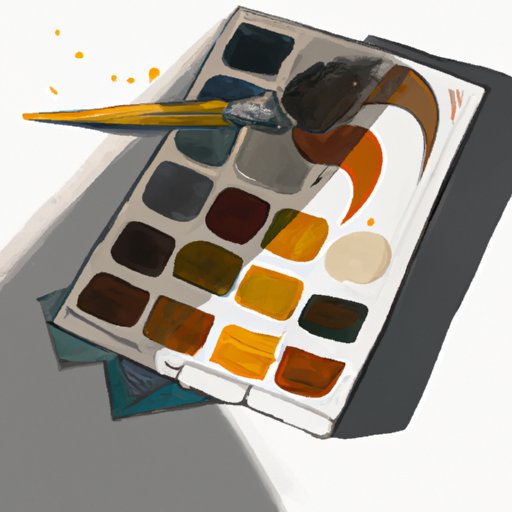Introduction
Painting is a form of creative expression that involves using pigments and dyes on a surface such as paper, canvas, or wood. It can be used to explore emotions, tell stories, or simply create something beautiful. In this article, we’ll explore how to get started with painting, from gathering the necessary supplies to adding the final touches.
Gather the Essential Supplies
The first step in getting started with painting is to gather the essential supplies. This includes paint, brushes, and a surface to work on. If you’re just starting out, it’s a good idea to stick with water-based paints like acrylics or tempera. These are easy to use and come in a variety of colors. You’ll also need a selection of brushes in different sizes. Finally, you’ll need a surface to paint on. Canvas is a popular choice for oil painting, while paper works well for watercolors.
When buying supplies, it’s important to buy good quality materials. Cheap materials may be tempting, but they won’t produce the same results as high-quality materials. Look for reputable brands and stores where you can find the best materials at a reasonable price.
Choose a Color Palette
Choosing a color palette is an important part of painting. A color palette is a group of colors that work together to create a unified look. It can help to set the mood of a painting and tie all of the elements together. When choosing a color palette, consider the mood you want to convey and choose colors that work together to achieve it. For example, warm colors like red and yellow can evoke feelings of energy and excitement, while cool colors like blue and green can evoke feelings of calmness and serenity.
Research has also shown that certain color combinations can be more pleasing to the eye than others. For instance, a study by the University of California found that people responded more positively to paintings with analogous color palettes (colors that are next to each other on the color wheel) than those with complementary color palettes (colors that are opposite each other on the color wheel).
Sketch Out Your Idea
Once you have your supplies and color palette, it’s time to start sketching out your idea. Sketching can help to give you a better understanding of how the painting will look before you start painting. It can also help you to experiment with different ideas and compositions. Even if you don’t consider yourself an artist, sketching can be a great way to get your ideas down on paper.
When sketching, it’s important to focus on the basic shapes and lines rather than getting too detailed. Start with a simple outline and then add details as you go. Think about how the composition will look and how the colors will interact. Also, remember to keep your lines light so that you can erase them easily if needed.
Begin Painting
Now it’s time to start painting! The best way to begin painting is to start with the background. This will give you a solid foundation to work from and help to define the overall shape of the painting. Use large brush strokes and think about how the colors will interact. Once you’ve finished the background, you can start adding details and depth.
When building up a painting, it’s important to take your time and build up the layers slowly. Use thin layers of paint and allow each layer to dry before adding another. This will help to ensure that the colors remain vibrant and the painting looks smooth.
Add Final Touches
The last step is to add the final touches to your painting. This is where you can really bring the painting to life. There are several ways to do this, such as adding highlights, shadows, and blending. Highlights are areas of bright color that stand out and draw the viewer’s eye. Shadows create depth and dimension, while blending helps to create a smooth transition between colors.
For example, when painting a landscape, you could use highlights to make the clouds stand out, shadows to add depth to the trees, and blending to create a gradual transition between the sky and the ground. These techniques can help to add interest and depth to your painting.
Conclusion
Painting can be a great way to express yourself and explore your creativity. To get started, gather the essential supplies, choose a color palette, sketch out your idea, begin painting, and add final touches. With practice, you can create beautiful paintings that capture the emotion and story behind your work. So why not get started today?
(Note: Is this article not meeting your expectations? Do you have knowledge or insights to share? Unlock new opportunities and expand your reach by joining our authors team. Click Registration to join us and share your expertise with our readers.)
